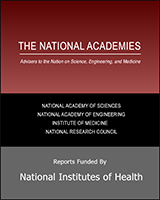BOX S-3Recommendations: Putting Knowledge into Practice
Funding and Implementation
Congress should establish a set-aside for prevention services and innovation in the Community Mental Health Services Block Grant, similar to the set-aside in the Substance Abuse
Prevention and
Treatment Block Grant. (12-1)
The U.S. Departments of Health and Human Services, Education, and Justice should braid funding of research and practice so that the impact of programs and practices that are being funded by service agencies (e.g., the Substance Abuse and Mental Health Services Administration, the Office of Safe and Drug Free Schools, the Office of Juvenile Justice and Delinquency
Prevention) are experimentally evaluated through research funded by other agencies (e.g., the National Institutes of Health, the Institute of Education Sciences, the National Institute of Justice). This should include developing appropriate infrastructure through which evidence-based programs and practices can be delivered and evaluated. (12-2)
The U.S. Departments of Health and Human Services, Education, and Justice should fund states, counties, and local communities to implement and continuously improve evidence-based approaches to mental health promotion and prevention of MEB disorders in systems of care that work with young people and their families. (12-3)
The U.S. Departments of Health and Human Services, Education, and Justice should develop strategies to identify communities with significant community-level risk factors and target resources to these communities. (8-2)
Researchers and community organizations should form partnerships to develop evaluations of (1) adaptation of existing interventions in response to community-specific cultural characteristics; (2) preventive interventions designed based on research principles in response to community concerns; and (3) preventive interventions that have been developed in the community, have demonstrated feasibility of implementation and acceptability in that community, but lack experimental evidence of effectiveness. (11-4)
(Also in Box S-5, Recommendations for Researchers)Federal and state agencies should prioritize the use of evidence-based programs and promote the rigorous evaluation of prevention and promotion programs in a variety of settings in order to increase the knowledge base of what works, for whom, and under what conditions. The definition of evidence-based should be determined by applying established scientific criteria. (12-4)
Data Collection and Monitoring
The U.S. Department of Health and Human Services should be required to provide (1) annual data on the prevalence of MEB disorders in young people, using an accepted current taxonomy (e.g., the Diagnostic and Statistical Manual of Mental Disorders, the International Statistical Classification of Diseases) and (2) data that can provide indicators and trends for key risk and protective factors that serve as significant predictors for MEB disorders. (2-1)
The Substance Abuse and Mental Health Services Administration should expand its current data collection to include measures of service use across multiple agencies that work with vulnerable populations of young people. (2-2)
Workforce Development
Training programs for relevant health (including mental health), education, and social work professionals should include prevention of MEB disorders and promotion of mental, emotional, and behavioral health. National certifying and accrediting bodies for training should set relevant standards using available evidence on identifying and managing risks and preclinical symptoms of MEB disorders. (12-6)
The U.S. Departments of Health and Human Services, Education, and Justice should convene a national conference on training in prevention and promotion to (1) set guidelines for model prevention research and practice training programs and (2) contribute to the development of training standards for certifying trainees and accrediting prevention training programs in specific disciplines, such as health (including mental health), education, and social work. (12-7)
Once guidelines have been developed, the U.S. Departments of Health and Human Services, Education, and Justice should set aside funds for competitive prevention training grants to support development and dissemination of model interdisciplinary training programs. Training should span creation, implementation, and evaluation of effective preventive interventions. (12-8)

Recommendations for Researchers. Research and interventions on the prevention of MEB disorders should focus on interventions that occur before the onset of disorder but should be broadened to include promotion of mental, emotional, and behavioral health. (more...)
NOTE: The first number refers to the chapter in which the recommendation appears; the second number references its order of appearance in the chapter.
